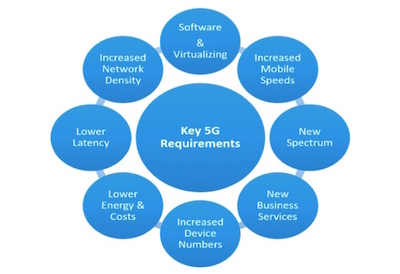3 Reasons Why Fibre is the First Choice to Support 5G Networks

Jan 22, 2020
By Ron Tellas
It’s no secret that 5G will bring us faster speeds, better performance and more reliable service for our mobile devices. (For example, 5G will enable users to download a high-def film in less than one second as opposed to the 10+ minutes it currently takes on 4G/LTE.)
But it will also place huge demands on wired infrastructure. Before 5G networks become prevalent, your network infrastructure needs to be able to reliably and continuously support thousands of devices (or more) — as well as the data collected and transmitted by these devices.
A good example involves the concept of autonomous vehicles. With 5G networks, connected cars will be able to communicate with each other to decrease safety hazards and anticipate potential problems, as well as read live map and traffic data to make route adjustments for time efficiency. To make this a reality, lots of real-time data will need to be collected and shared over a network so that autonomous, immediate adjustments can be made.
Every version of mobile phone networks has been created with a specific purpose in mind:
• 1G was introduced in 1982 to support analog voice
• 2G was introduced in 1991 to support digital voice and messaging
• 3G was introduced in 1998 to support data and multimedia service (like email)
• 4G/LTE was introduced in 2008 to support IP voice and data, as well as video and mobile internet service
• 5G — the latest generation — is designed to support IoT and Big Data (like connected/autonomous cars, factory robotics, smart cities, etc.)
When you compare these five generations, it’s easy to see why 5G will need so much more from a wired network than its predecessors. To be considered “5G compatible,” a mobile device must stay connected and able to stream 4K-quality video seamlessly — no matter the traffic density.
Why fibre is necessary for 5G networks
According to a 5G operator survey released by the Telecommunications Industry Association (TIA) in 2017, 5G operators consider fibre important for the backhaul portion of 5G networks (in fact, 83% say fibre is “very important”). By the end of 2020, 33% expect their companies to be offering commercial 5G services.
Although every network is different, one thing will remain true for each one that supports 5G: lots of fibre will be needed. Why? There are a few reasons.
1. Creation and transfer of real-time data
5G supports IoT and Big Data, which rely heavily on real-time data collection and transfer. Because decisions are being made instantaneously (and automatically, in many cases) based on this data, lower latency and higher bandwidth levels are needed to ensure that the data gets to where it needs to go quickly.
Because of its unlimited bandwidth potential, fibre is the cable of choice to support these bandwidth levels.
2. Increasing network demands
Because of this 24/7 data collection and transfer, there are many more demands made on networks: higher network availability levels, full wireless network coverage (no dead spots), lower latency and higher bandwidth capabilities (as mentioned earlier) – all caused by an influx of connected devices.
In part, this is thanks to growing numbers of people and the devices they carry, which connect their users to unlimited data. But there’s another layer of connectivity at play today, too: Devices that aren’t controlled or managed by people (PoE LED lighting fixtures, surveillance cameras and digital displays, for example). Instead, these devices connect directly to the network and operate independently.
By bringing fibre closer to the edge of the network, stadiums and arenas can take advantage of 5G’s improved bandwidth and capacity levels.
3. Higher radio frequencies and small cells
To achieve expected performance levels for 5G networks, more small cells (or nodes) and mobile edge computing will be needed to eliminate network bottlenecks. These small-cell deployments often utilize the millimeter wave spectrum, relying heavily on fibre cabled connections for the backhaul portion of the network.
To handle larger amounts of data, 5G uses much higher radio frequencies than existing mobile networks. These higher frequencies, however, have very short ranges. For 5G to work as expected and provide multi-gigabit service to users and devices, many additional “cells” covering small areas must be installed throughout a venue (spaced as close together as 200 feet apart, according to some experts).
To provide multi-gigabit service to the users and applications that want access to 5G networks, the cells redistribute signals from cellular carriers through the air or via direct line, bringing them inside and/or dispersing them across a vast area. Without them, carriers struggle to get their signals indoors. Based on application size, they may take the form of femto cells, small cells, enterprise radio access networks (RAN), distributed antenna systems (DAS) or Cloud RAN (CRAN).
Fibre is the preferred option for 5G because of its scalability, security and ability to handle the vast amount of backhaul traffic being generated.
In addition to being the No. 1 option for network backhauls, fibre is also preferred for the fronthaul portion of the network as well (the portion that connects the small cells).
It can handle 5G’s increased speeds with lower attenuation, is immune to electromagnetic interference and offers practically unlimited bandwidth potential.
Getting ready for 5G
The launch of 5G will bring enhanced capacity and lower latency straight to networks. The legacy copper-based infrastructures that have supported connectivity so well for so long won’t be able to keep up with 5G bandwidth demands.
Belden can help ensure that you have the right fibre optic cable system in place to support enhanced 5G capabilities when they arrive. For more information, visit https://www.belden.com/products/enterprise/fiber.
Ron Tellas is a SME in RF design and Electromagnetic Propagation and has BSEE from Purdue University, a MSEE from IIT, and a MBA from Purdue University. Ron joined Belden in 2016 to help define the roadmap of technology and applications in the enterprise. Prior to this, he developed cables and connectivity for Panduit and Andrew Corp.
This article was first published online by Belden.
Image: JMA Wireless










![Guide to the Canadian Electrical Code, Part 1[i] – A Road Map: Section 52 — Diagnostic imaging installations](https://electricalindustry.ca/wp-content/uploads/2022/11/Guide-CE-Code-2.png)






